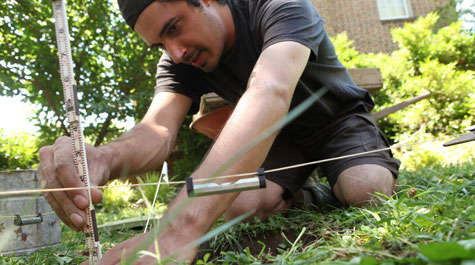Archaeologists seek evidence of 18th-century Bray School
An archaeological collaboration between William & Mary and the Colonial Williamsburg Foundation hopes to find conclusive evidence of the Bray School, an 18th-century institution dedicated to the education of free and enslaved black children.
Terry Meyers, Chancellor Professor of English at William & Mary, has collected evidence that indicates that the original Bray School building still exists—but the building has been modified extensively over the years and even moved from its original site.
Archaeology near the site of what now is a college dormitory may bolster the claim that the existing building is the nation’s oldest standing school used for the instruction of black children. The Bray School is one of the topics being investigated by the Lemon Project, an ongoing scholarly initiative at William & Mary focused on the 300-year relationship between African Americans and the College.
The Bray School Archaeological Project (BSAP) is a pair of field schools excavating the area near what Meyers and others believe is the original site of the Bray School, the Dudley Digges House at the intersection of Prince George and North Boundary streets in Williamsburg. The Bray School, established with the support of Benjamin Franklin, operated in Williamsburg from 1760 to 1774. The school was in the Digges House from its inception until 1765, when it moved to another location.
Meyers believes that Franklin recommended Williamsburg as a location for establishing the Bray School on the basis of an institutional connection with the College of William & Mary. Therefore, “William and Mary appears to be the first college or university in America to concern itself as an institution…with the education of blacks, free and enslaved,” Meyers wrote in the Dec., 2010 issue of the peer-reviewed journal Anglican & Episcopal History.
Archaeological schools are conducted jointly each summer by the Colonial Williamsburg Foundation and William & Mary’s Department of Anthropology. Co-leaders of the BSAP are Neil Norman, assistant professor of anthropology at William & Mary, and Mark Kostro of the Colonial Williamsburg Department of Archaeological Research.
Work began on May 29 in the garden area to the south of Brown Hall, a William & Mary dormitory known to be the original site of the Digges House. The project began with shovel testing, excavating small holes every five meters.
“The idea is to get a little glimpse over a broad area of where there might be artifacts or features that potentially relate to the school and then based on that information, we’ll dig larger units,” Kostro explained.
The BSAP’s first day of shovel testing brought up a number of artifacts, including beads, ceramic fragments, the inner workings of a watch and parts of smoking pipes—but nothing dating to the time of the Bray School, Norman said.
"I'm delighted to see the dig under way,” Meyers said. “I hope they'll find pencils embossed ‘The Bray School,’ but I would be happy with any evidence that might clarify what I think is the likely link between the Digges House at that location and the Bray School. The dig is a first step towards solving a fascinating mystery."
Norman and Kostro both agree that the recovery of embossed pencils —or any single artifact that forges an unambiguous link to the Bray School—is a long shot.
“This isn’t like a shipwreck. There’s not going to be a ship’s bell with the name of the ship engraved on it,” Norman said. “The equivalent here would be something like a lead plate with ‘Bray School’ stamped on it. We’re not expecting to find anything like that, but there could be a lot of little things that make up a preponderance of evidence that would let us say this must be the place.”
He said that artifacts that point toward the location of the Bray School would include needles, thimbles or other items associated with sewing, an activity known to be taught to Bray School students. The case would be strengthened by the recovery of play items such as jacks or other toys, he added. A “home-run” find, Norman said, would be a slate used for classroom work.
Kostro noted that any archaeological evidence would augment the scholarship conducted by Meyers connecting the existing structure to its original site. The Dudley Digges building still stands, but in 1930 it was moved from its original location down to 524 Prince George St. The building now houses William & Mary’s military science and ROTC programs.
The archaeologists are looking for evidence of the foundation of the Digges House, though Kostro warns that the foundation may have been destroyed during the 1930 construction of Brown Hall. Even if Brown Hall sits squarely atop the original Digges House foundation, as the archaeologists suspect it may, the site still holds plenty of possibility. Norman, a specialist in the archaeology of Africa and the African diaspora, notes that in African cultures much of the actual work tended to be conducted outdoors. Therefore, he added, the yard areas of African American sites often are the richest in artifacts.
Two five-week field schools will work on the project over the summer, Kostro said. Norman explains that the summer field schools teach William & Mary students the skills necessary to recover and interpret artifacts. The most important skill, he says, is patience.
In the summer of 2011, W&M/CW field schools excavated the area around the Brafferton, the site of William & Mary’s Indian School from 1723 until its closure during the Revolutionary War.
“Field schools are one of the fundamental building blocks in archaeology for undergraduates,” he said. “We expect that each one of our archaeology concentrators will have some field experience.”
The excavation is open to the public and Norman notes that volunteers are welcome to participate. Anyone wanting to volunteer should contact Norman at nlnorman@wm.edu.
 Skip to main content
Skip to main content

